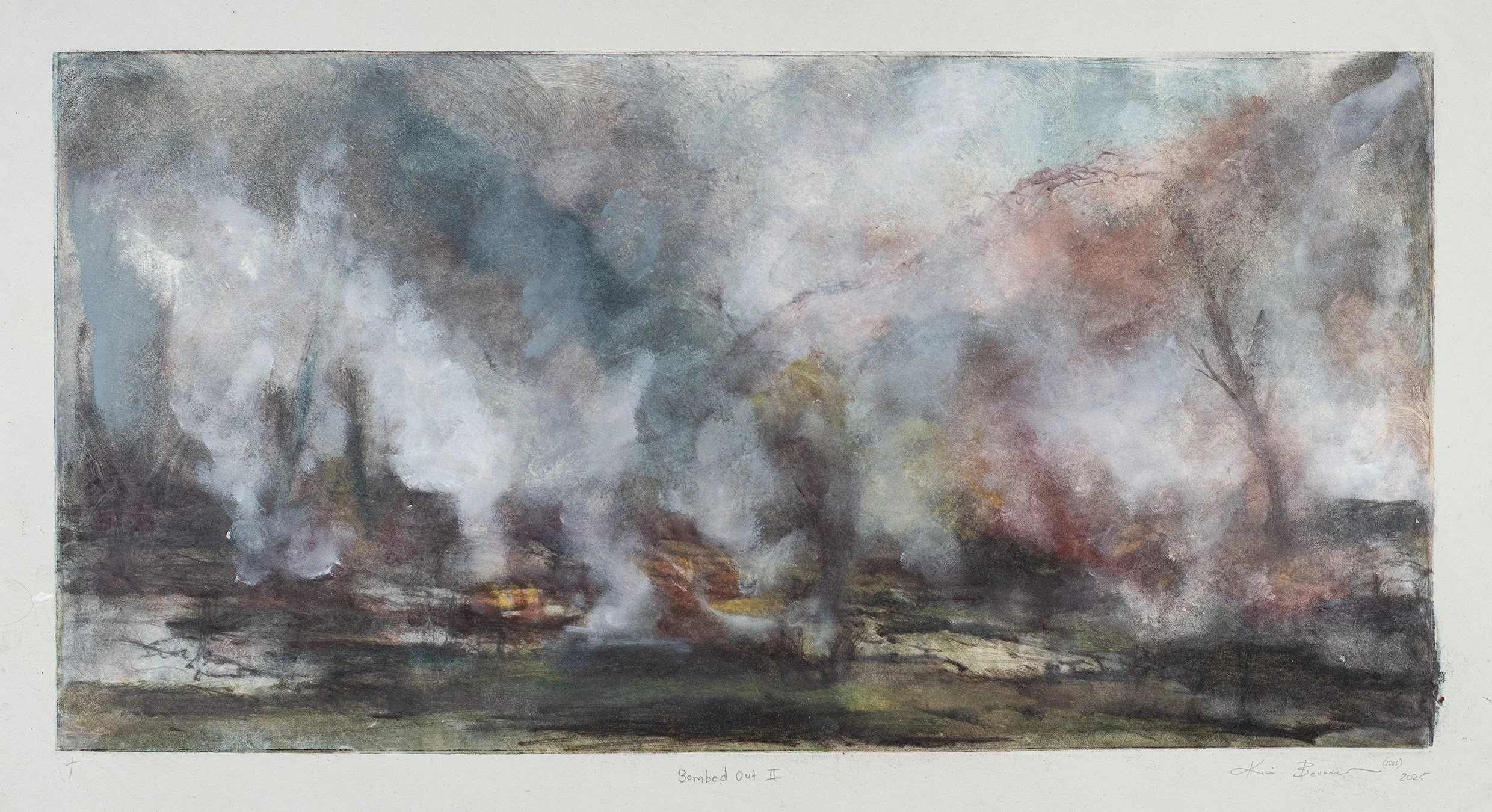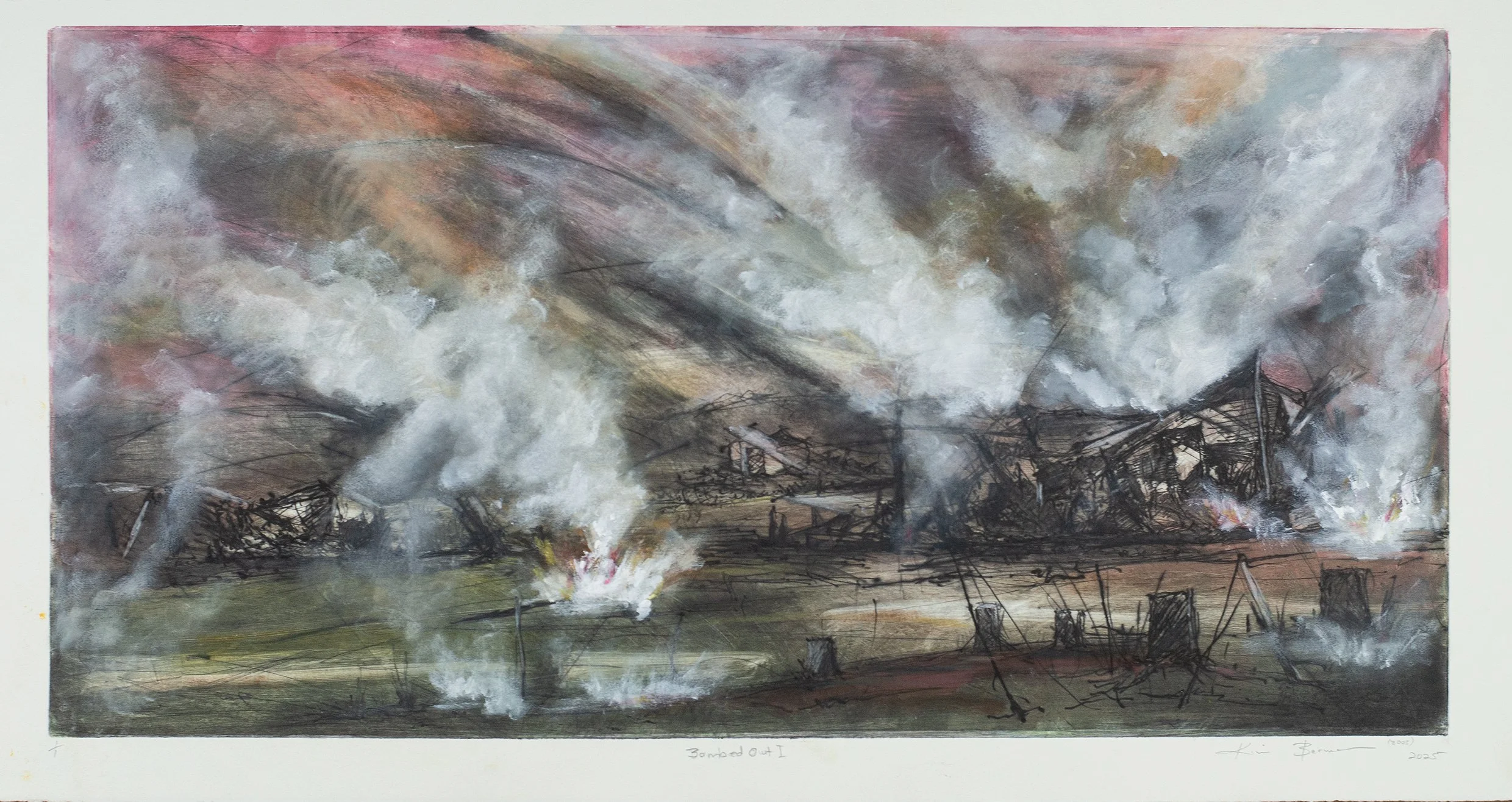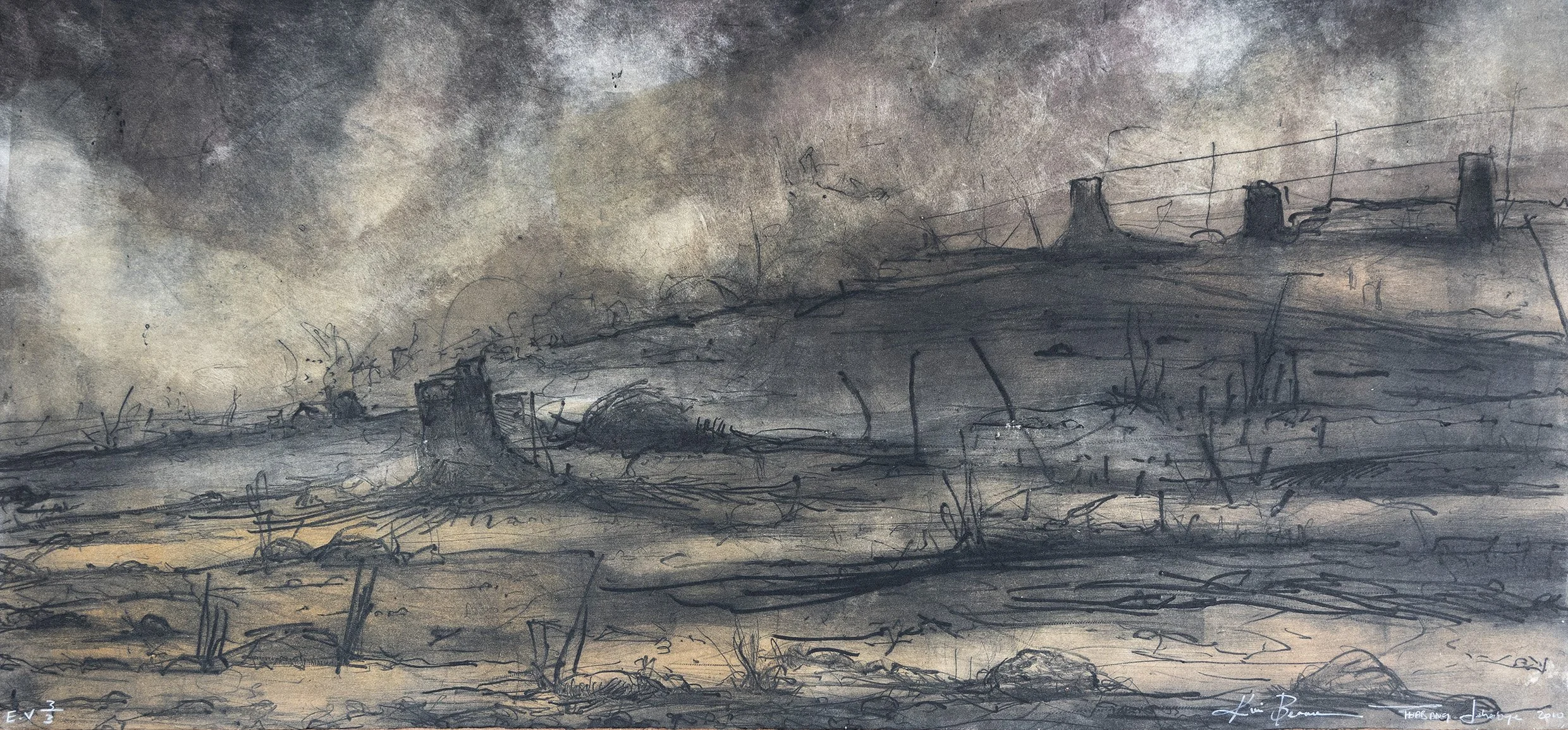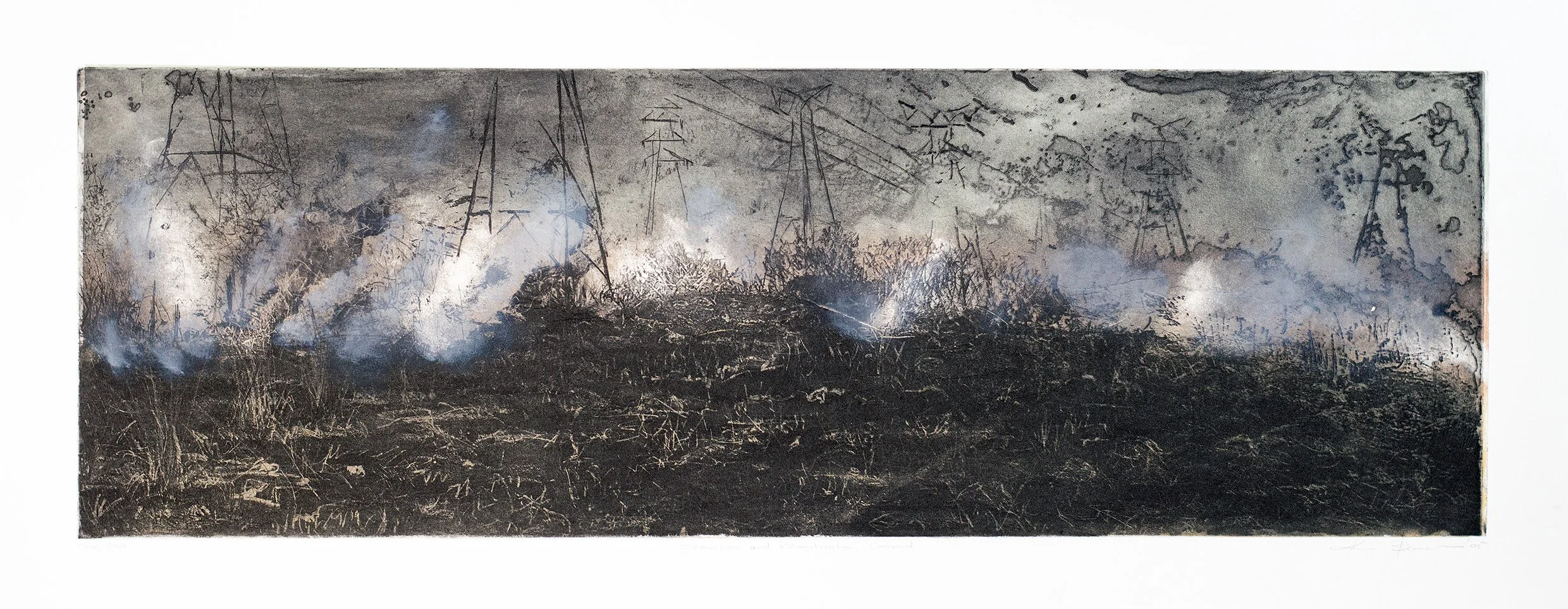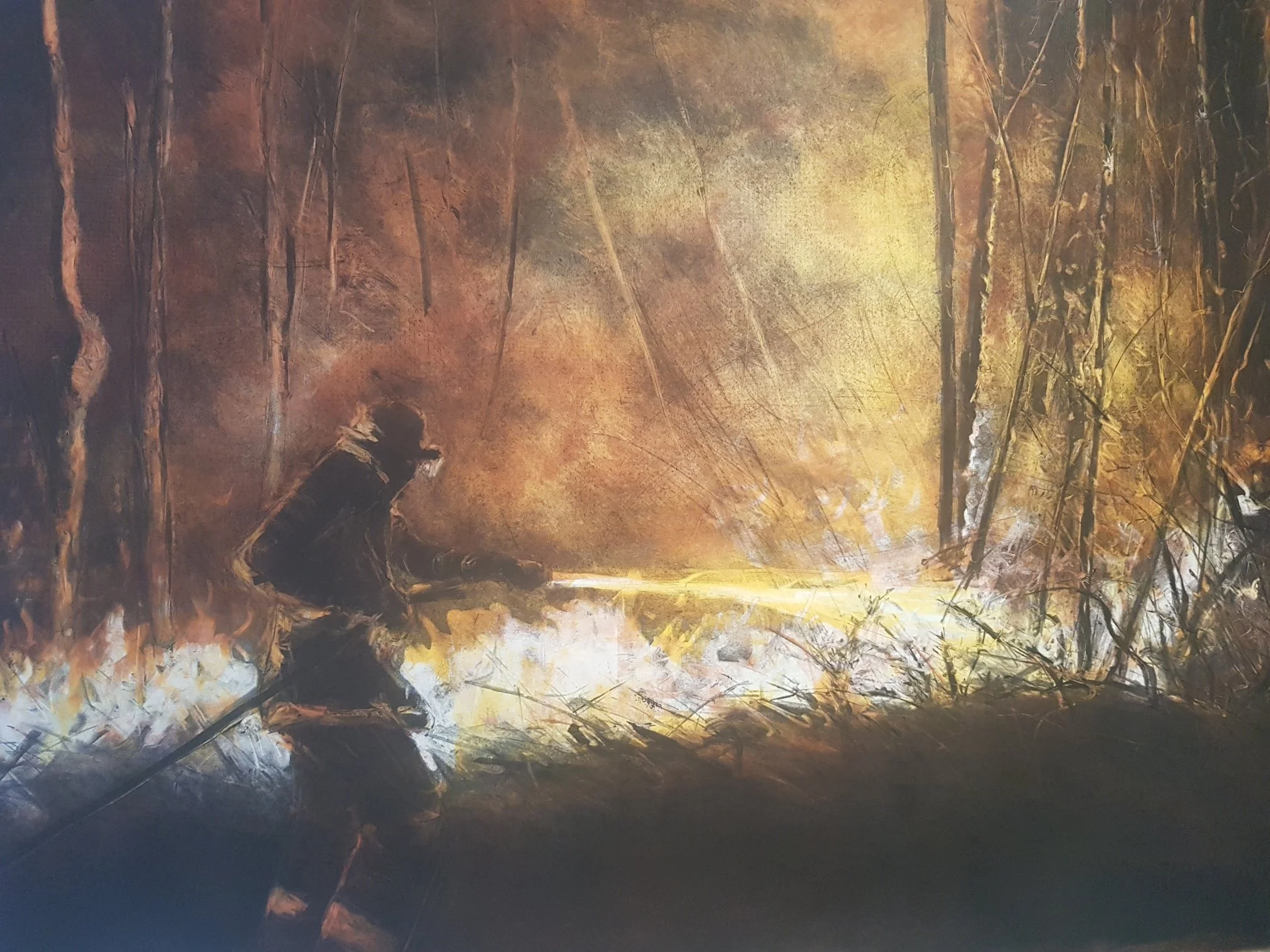Fire and Smoke
Smoke screens and fires that purge have been a constant feature in my work. In preparation for this exhibition, I found a damaged print rolled up, subsequently called Smoke dreams revisited and, acknowledging the year the plate was made in 2005/6, I reworked it - 20 years later. Adding layers of smoke, I remembered the eerie premonition of earlier prints with smouldering remains, weeks before Artist Proof burned down in 2003.
Weeks after the devastating war in Israel and Palestine following the October 7th massacre, I made a new body of work. I was at a loss as to how to process the war, and recorded images of bombs and destruction, which I monoprinted on found plates from 2006. Following that I had a week’s residency at the Artists Press and completed a series of fire cycles I called Spring of Storms. These monoprints evoke traces of war and social and environmental damage that disrupt a balance of justice and humanity. Fires have long served as a metaphor in my artwork as both destructive and regenerative. They hold the paradox of beauty and pain; as well as hope emerging through a smoke-filled sky.
Fire Regimes
Mark Auslander
For two decades my wife Ellen and I have had the privilege of living with two of Kim Berman’s spectacular large prints, produced out of plates that survived the tragic 2003 fire in Artist’s Proof Studio that led to the death of the studio’s co-founder, Nhlanhla Xaba. The works depict the enigmatic landscapes of the Witwatersrand between Pretoria (Tshwane) and Johannesburg, sites of frequent winter fires, at times erupting into tides of conflagration. In Excavation and Reconstruction Eastrand, white plumes billow up from the grasslands, partially obscuring the electrical pylons that march across the scarred expanse. Some of the dark scratches in the lower reaches of the image are preserved from previous etchings on the old plate, so the work still bears the scorch marks of that fateful studio fire. It has long seemed to us to be a vibrant, simmering funeral pyre, dedicated both to Xaba’s memory and to the Phoenix-like project of APS, miraculously reborn out of crisis time and again.
Excavation and Reconstruction, Eastrand, 2005, Monoprint, from variable edition
Here, we see one of the mythic archetypes that inform Kim’s repeated explorations of fire and smoke across four decades of printmaking: perpetual cycles of death and the regeneration of life, and hints of hidden dynamics below the surface - the heavy burdens of history, and the gradual taking-shape of possible futures.
Pyro-geographers use the term “fire regimes” to reference dynamic ecological matrices of periodic burning, followed by the renewal of organic life; and the grasslands of the Highveld depend on wildfire to germinate and spread their seeds, replace nutrients, and control invasive species.
The term “fire regime” resonates strongly in South Africa, a nation shaped by successive sociopolitical regimes marked by particular relations to fire. For millennia, indigenous communities practiced controlled burning to encourage healthy grassland renewal for livestock and to nurture the growth of medicinal plants. Colonial and Apartheid era landscape management, in turn, was marked by futile efforts to suppress fire. Post-apartheid wildland managers, often partnering with indigenous healers, have again resurrected the ancient techniques of controlled burning, to cleanse and refertilise.
Under Apartheid, fire had other potent, painful associations. Informal settlements of migrant workers were routinely displaced by state agents through house burning.Witdoeke(white cloth) vigilantes, acting at the behest of the government, used arson to force out political rivals, often associated with the United Democratic Front (UDF). During the country’s “State of Emergency”, popular township street committees violently assaulted suspected informers and infiltrators by “necklacing” them - forcing their necks into old tyres which were doused with petrol and ignited. Fire was weaponized on all sides of the conflict as conditions spiralled into cycles of retribution and revenge.
Post-1994 South Africa has left those dark days behind, but in Kim’s work, the traces of Apartheid-era struggles endure. Fires still burn and embers still smolder. I suggest that, for Kim, combustion is not only about cycles of destruction and renewal, but also about the coming to consciousness, the attaining of a deeper apprehension of the truths of the world that we normally turn our backs on. Here, I see a particular affinity between Kim’s vision and that of author J.M. Coetzee, who has long seen in fire a core metaphor for the fundamental transformation of mind. In this light, Kim’s 2002 Smokescreen, created eight years after Mandela’s election, could be read as a critique of the illusory claim that the nation was existing in an entirely “post-Apartheid” moment, despite the vast economic inequality, dispossession, and desperation that continued behind the narrative of liberation and transformation.
Smokescreen, 2002, Monoprint from variable edition
A word here on smoke. Chemists tell us that smoke is a byproduct of incomplete combustion. Full combustion, fueled by plentiful oxygen, produces only carbon dioxide and water, that is to say, transparent or translucent steam. Yet if supplies of oxygen are limited, as is the case in most fires, then the product of fire becomes aerosolized particulate matter - soot, tar, ash and other chemical compounds - which manifests as opaque smoke. So smoke is more than just a sign of fire, it indicates a process that is interrupted or incomplete, obscuring vision while revealing a key process that remains unfinished or stalled. Smoke thus is profoundly “good to think” with about the long-term legacies of Apartheid, which have never fully gone away or played themselves out.
Three decades since Apartheid’s assumed conclusion, the smoke still lingers. Kim has continued to draw on fire and smoke’s uncanny capacity to bring awareness and render visible precisely that which is conventionally concealed. In her monotype World on Fire, a lone firefighter tries to hose down an entire forest caught in the cataclysm of global climate change. I take the firefighter as a symbol for the artist herself, confronting the enormity of a dynamic in which we are all implicated. Fire and smoke equally permeate the artist’s contemplation of the unresolved contradictions of the post Cold War world, including the brutal war in Ukraine.
World on Fire, 2020, Monotype
Since the terrible events of October 7, 2023, Kim has excavated the painful intertwined landscapes of Israel and Palestine. Here, she is as personally involved as she was in the struggle against Apartheid, but perhaps with greater anguish and ambivalence. A longtime advocate of peaceful coexistence and non-militarized solutions, she has loved ones in Israel across the political spectrum. She is conscious that in the shadow of Gaza, many erstwhile progressive allies - in South Africa and elsewhere - have become suspicious, even condemnatory of Jews such as her, regardless of their political history and contributions to the struggle.
Consider Kim’s recent Frontline, an image which could be lifted from the TV coverage of Gaza and Israel. Amidst the obscuring smoke, we glimpse an unstable telephone pole, perhaps signifying the breakdown of communication between the warring Children of Abraham at the current moment. The disaster billows into both sides of the separation barrier, so that it becomes impossible to determine which side is which. The rising of wraith-like smoke evokes the spectral dead of both sides.Thesmokyforms merge above the separation barrier into a common, diffused, amorphous mass that fills the sky, like lamentations rising to the heavens, from all quarters. I read this image, filled with the obscurity of rising smoke, as an outward projection of the pain and internal conflict within the artist’s inner psychic state. Fire sometimes births resolution and clarity, but here, smoke predominates. We sense the overwhelming expression of grief, born of the artist’s collective and specific love for humanity, but which is, at the present moment, rejected by polarized partisans on all sides.
Frontline, 2024, Reclaimed plate with monotype
It is impossible to look at these images of rising smoke and not be mindful of the Holocaust. The smoke that issued from the crematoria and pyres of Auschwitz-Birkenau, Majdanek, Treblinka. Sobibor, and Bełżec for some had been seen to mark a decisive break in human history – a hope that the pivotal historical event of the Shoah would reorient humanity’s course and put an end to genocidal terror. Never again. But this seems not yet to be. Smoke rises everywhere, across all borders. We are all on the frontline, and that line seems to run right through us all, piercing us to the quick. Our collective process of ethical evolution remains incomplete and unfinished.
And so in Kim’s print worlds of fire and smoke, we find ourselves standing, together and apart, still half-clothed in the hazy apparitions of No Man’s Land.












